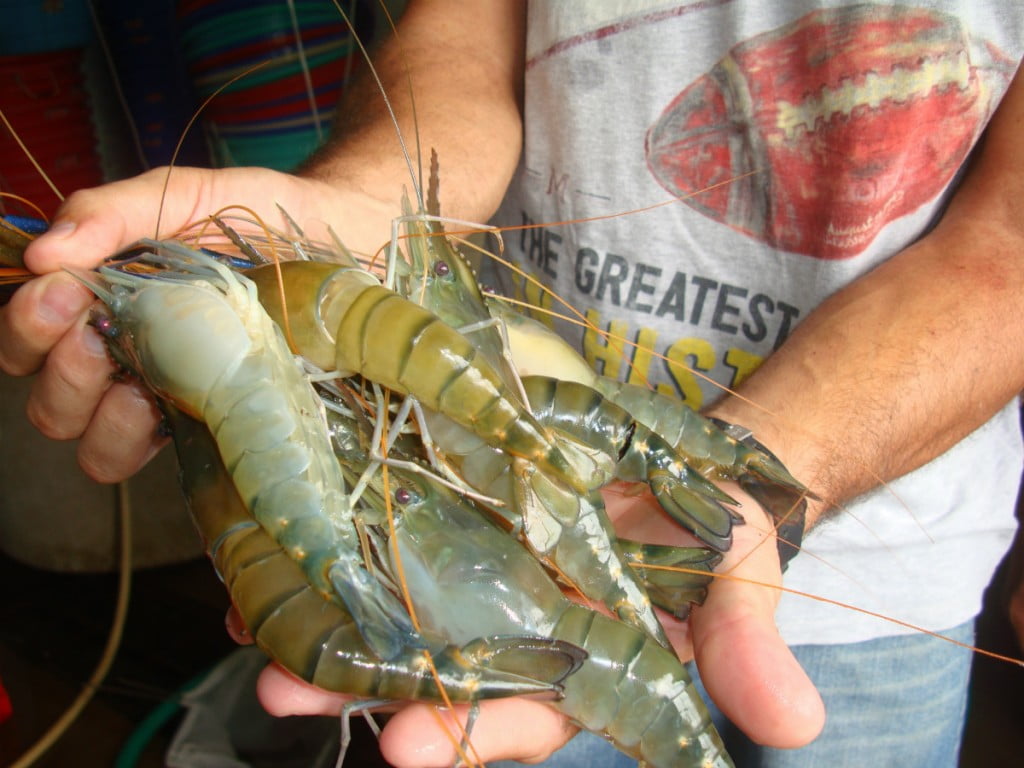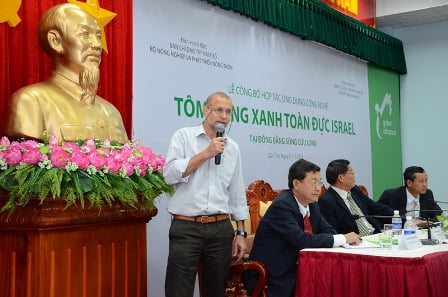This is a story which begins in laboratories in the Negev desert and ends in aqua-farms off the coasts of China. The heroes: prawns. The aim: more profitable crustaceans. The how: giving the prawns a sex-change.
Related articles
- EdenShield Invents Product That Makes Crops ‘Invisible’ To Pests
- Israeli Technology Behind Europe’s Largest Fish Farm
A researcher at Ben Gurion University (BGU) has developed a technique for turning male prawns into a special type of female who yields only male progeny. The patent of the discovery was licensed to Tiran Group, an Israeli shipping company with a growing aquaculture business in China and Vietnam. Male prawns grow twice as large as female ones. Therefore, cultivating these transsexual prawns that only have male descendants can potentially double the profits for farmers and reduce by half the price of prawns on the market.
Twisted as it may sound, the technique is benign. It’s even mostly safe from the criticism of bioethics advocates because it doesn’t produce genetically modified organisms (GMO). How is this possible? The answer is gene-silencing.
“Like flipping a switch on or off”
To learn more about gene-silencing, NoCamels travelled to Be’er-Sheva to meet Professor Amir Sagi, president of the International Society for Invertebrate Reproduction and Development and member of the academic staff at Ben Gurion University. He is also the father of this discovery. He defines gene-silencing as “interrupting” or “interfering with the expression of a certain gene.”
In a nutshell, imagine we could lay our DNA out before us. “DNA is made of genes and every gene contains information on how a part of our body will be,” Sagi explains to NoCamels. Now imagine every gene on our laid-out DNA was a switch. By activating a switch, we are turning a gene’s information “on” and into a palpable reality (making our eyes a certain color, our hair curly, etc.). According to Sagi, this occurs in the following way: “A copy (called RNA) is made of every gene. Each RNA transcript will then be de-codified and turn into a protein.”
From the moment we are born, all our genes are “switched on”. But if we were we to turn off a specific gene, it wouldn’t de-codify and a part of our body would not change in shape, size, color or even cease to exist. Our DNA remains intact, except for one gene that no longer works, like having a faulty pixel on a TV screen. This is gene-silencing.
“The idea of gene-silencing,” explains Sagi, “is to interfere with the translation of DNA into RNA into protein.” This means the process does not create genetically modified organisms (GMOs), “it’s a temporal interruption so it doesn’t modify the genome. These changes won’t pass on to the next generation.”
Creating a manly female to ensure male offspring
Professor Sagi’s office bears witness to his passion for his work: he sits in a room jammed with little plastic crustaceans. Magnetic crabs cling to his whiteboard, cute cartoonish lobsters sit on his desk and unidentifiable plastic antennae poke out from among his bookcases filled with literature on marine biology.Under the vigilance of these inert pearly eyes, Amir Sagi gave NoCamels a crash-course in genetics to better understand his discovery. “I first noticed the growth difference between male and female prawns back in 1986, the times of my PhD,” Sagi explains. “And about three years ago, our research discovered the gene which codifies a prawn’s maleness.” The gene, baptized Mr – IAG, encodes the “androgen hormone”, responsible for “male appearance, activity and sexual characteristics.”
Thus, by “silencing” this gene in undeveloped males, the prawn will develop as a fully functional female while still containing male DNA. And because it is female DNA that is responsible for adding the femininity genes into the mix, by pairing up one of these “neo-females” with a regular male, their offspring will be 100 percent macho.
Sign up for our free weekly newsletter
SubscribeFrom discovery to biotechnology
Last year, the discovery jumped from the Professor’s lab to aquaculture farms in China. According to Sagi, although gene-silencing is a known technique in the scientific world and has often been used for research, “it has never been used in aquaculture.”
The jump from the lab to the business world was possible thanks to the funding sources. Apart from the many funding agencies that helped at basic scientific level, there were two key investors: the National Institute for Biotechnology in the Negev (NIBN) and the Israel shipping agency Tiran Group, to which the patent is fully licenced and which holds the sole right to commercialize the technology. “Only with those two we were able to take it from an abstract scientific idea into a biotechnology that could be used in the field.”
Professor Sagi redirected us to Haim Avioz, managing partner of Tiran Group, for the next chapter in this story: business. I met Avioz in Tiran’s office in Haifa amongst model ships, maps of the oceans and a general seafaring atmosphere.
“The university contacted us because we’re Israeli and we’re working in aquaculture in China,” Avioz tells NoCamels. Tiran Group, a shipping agency founded in 1995, decided it wanted to stand on more than one leg, and so began investing in various fields. Aside from shipping, they also now run Tiran Trading, which, born in 2001, is involved mainly in import from China into Israel and other markets and Tiran Agroproducts (2009), which exports Israeli agro-products like potatoes, grapes, mango and avocado. Last but not least, they put a foot in the field of aquaculture.
Matching academia with business
Tiran Group gambled to expand their market by opening an aquaculture branch in the Far East called New Horizons. Avioz: “We entered the aquaculture business because what we see in the world is less fish in the sea and more people willing to eat seafood for its protein, which is very healthy.”
Tiran own aquafarms in China since 2002, in which they breed tilapia (aka Saint Peter fish) imported from the Sea of Galilee. They recently started breeding the “neo-female” prawns in these farms. According to Avioz, from the consumer point of view, the advantage of this use of gene silencing is that “the consumer gets a bigger prawn, which looks better on the plate and contains more meat, for the same amount of time, energy and money invested.” Therefore, Avioz admits, if production doubles or even triples, farmers will increase their income and the price per gram could consequently become two or three times cheaper.
The expanding shipping agency also closed a deal in late 2012 with a Vietnamese company called Green Advances in order to implant the technology in Vietnam and thus advance aquaculture in that country. In November 2012, Amir Sagi attended the signing ceremony in Can Tho, Vietnam, between Tiran Group and Green Advances, along with Haim Avioz, Israeli commercial attaché to Vietnam Zafrir Asaf and Green Advances Chairman Phan Minh Tuan
This is proof, as Haim Avioz proudly points out, that Tiran Group and BGU are “working hand in hand” on this project. “The cooperation between an academic research center and a private company is important,” Avioz remarks, “It opens room for much closer cooperation between academia and the industry.”
Photos: courtesy
Related posts

Resilient And Nutritious New Plant-Based Milk Aims To Make A Splash

Chocolate From Cultivated Cocoa Comes Without Environmental Toll

Plastic Fantastic: Startup Takes PVC Back To Its Crude Oil Roots






Facebook comments